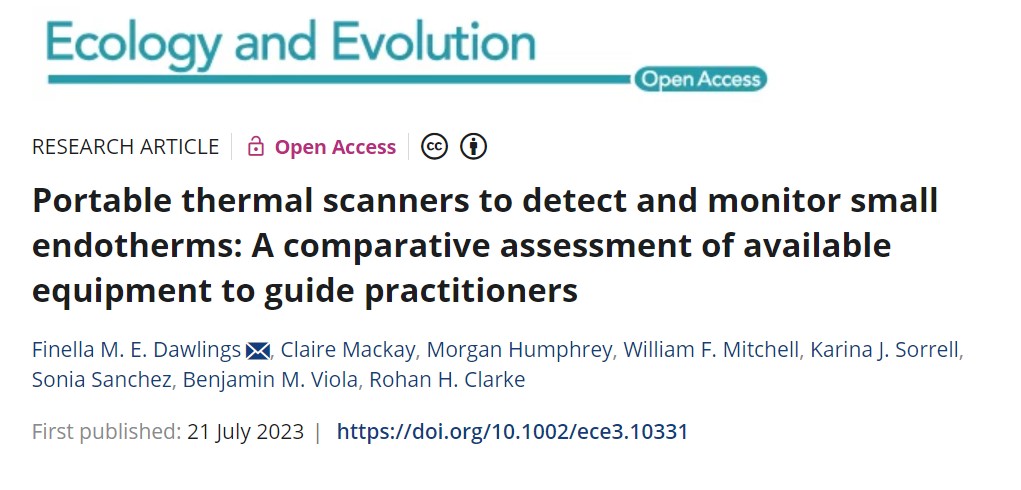
A scientific study on wildlife detection with different thermal cameras
Here’s an interesting – open access – paper that one of Australia’s top mammalwatchers, Rohan Clarke, and his team in Australia just released. They compared three different thermal cameras and their effectiveness in detecting Plains-wanderers (a bird, albeit a mammalish one in my opinion) in Australian grassland.
In a nutshell: you get what you pay for. Indeed you might be better not getting the cheapest of the cameras at all and sticking to a spotlight instead.
The full paper is here – I am very happy to see these sort of studies looking at how useful this still quite new piece of mammalwatching kit really is. Meanwhile am still waiting for someone to calculate the optimal speed for driving while spotlighting!
Jon
Post author
3 Comments
-
-
Nathan Myhrvold
It turns out that there is a scientific study directly comparing thermal imaging to spotlighting, but it is a 2001 paper so the technology has advanced a lot. https://www.researchgate.net/profile/Stefano-Focardi/publication/261825839_Comparative_Evaluation_of_Thermal_Infrared_Imaging_and_Spotlighting_to_Survey_Wildlife/links/5b6d4e4545851546c9f9ba7d/Comparative-Evaluation-of-Thermal-Infrared-Imaging-and-Spotlighting-to-Survey-Wildlife.pdf The study finds that thermal is superior to spotlighting for some animals (wild boar) and equivalent for others (red fox, fallow deer). I would guess that technological improvements since 2001 would shift things further toward thermal. This 2021 study claims that thermal is better for detecting small mammals in tropical rainforests https://bioone.org/journals/wildlife-research/volume-49/issue-6/WR21130/Thermal-imaging-outshines-spotlighting-for-detecting-cryptic-nocturnal-mammals-in/10.1071/WR21130.short , which unfortunately is not open access, so one would need to obtain the paper via university library access. This 2022 paper https://onlinelibrary.wiley.com/doi/pdfdirect/10.1002/wlb3.01030 says that thermal is better for Hyena in surveys of the Serengeti, but spotlighting is better for lions. This 2020 paper https://www.researchgate.net/profile/Hugh-Mcgregor-2/publication/349997248_Effectiveness_of_thermal_cameras_compared_to_spotlights_for_counts_of_arid_zone_mammals_across_a_range_of_ambient_temperatures/links/604fce0e299bf173674643b6/Effectiveness-of-thermal-cameras-compared-to-spotlights-for-counts-of-arid-zone-mammals-across-a-range-of-ambient-temperatures.pdf finds that thermal is best for small desert rodents, but has no advantage for feral cats due to their strong eye shine.
Leave a Reply
You must be logged in to post a comment.


Nathan Myhrvold
Looks like a great study – thanks for posting about it.
I have had high hopes for my thermal cameras, but mostly they seem to be good for niche uses. I have one thermal camera designed for cars mounted on my 4×4, with a screen that mounts to the dash. The motivation was to avoid hitting animals when I am driving at night in a national park or wilderness area, and for that it is fantastic. Consequently it would also be very useful for spotting mammals on the side of the road, or crossing the road, on night drives. However, this set up is not easy to take with me, so it is limited to places I can drive to in the US.
Several vehicle mounted cameras, aimed to have side views as well as straight ahead, each with its own monitor, MIGHT beat spotlighting some places. But where do you find a set up like that?
For other trips, I have one of the handheld, high end Pulsar thermal cameras which I have brought to Africa, Sabah and Patagonia. It is useful in some cases, but the field of view is so small compared to normal human vision that it is hard to see it replacing spotlighting.
—————————–
EVERY night drive I am on causes me to wonder about the issue you raise – what is the optimal search strategy? If you drive faster, you will miss some animals, but you will also cover more ground. I have thought about making a mathematical model of this, but so far have not. My conclusion so far is that it depends on the “spotting success rate” as a function of speed. If you drove at 100 miles per hour (just as a thought experiment) you would cover a lot of ground, but it might be so fast you miss lots of animals. If you just stop at one place (zero speed) you won’t miss animals but you will only see what wanders by.
For my trip to Deramakot earlier this year, Tom at AAB advised to have two guides spotting, each with their own side of the road to watch. It was pretty easy to see that this made it possible to drive faster without missing animals. So even if there was a mathematical formula for how fast you should drive, it would need a parameter that measures how good your spotting is a function of speed.